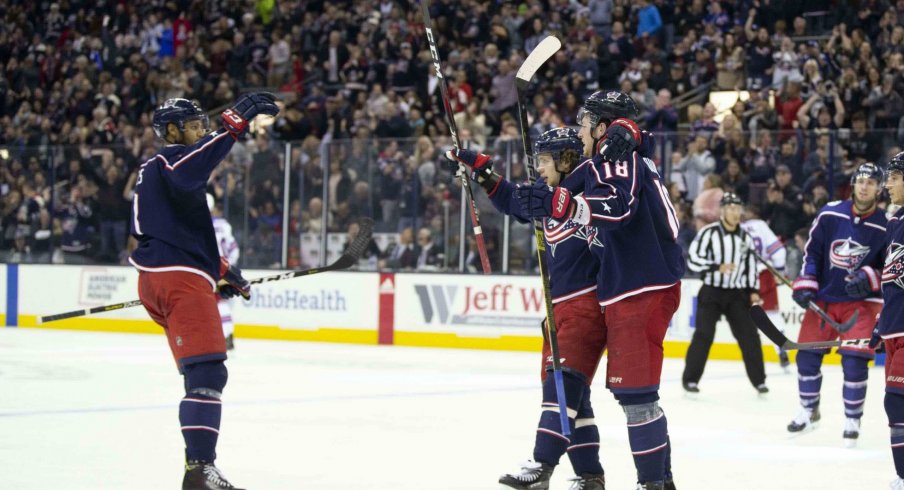If the Columbus Blue Jackets seek any sort of postseason success, they absolutely have to improve their power play.
Improve is a better word than "fix", here, because there wasn't anything necessarily strategically wrong about the way the power play was operating in the first month of the regular season.
In fact, even when the fanbase called for assistant coach coach Brad Larsen's job after a 21-man advantage scoring drought, management held their ground and were patient. And there was a reason for that.
It was a calculated and informed risk but the players took it upon themselves to turn the ship around. They knew they had the capability of having an elite power play, they just need to put the work in to make it happen. As the saying goes: there are too many good players for this thing not to work.
After a nightmarish 4-1 loss to the Los Angeles Kings on Nov. 3, captain Nick Foligno spoke out on the team's attitude as a whole, pointing to the blame not being on the coaches preparation:
"I mean, enough's enough. There are only so many rah-rah speeches you can give," said Foligno. "Only so much the coach can say. Eventually, you have to go out and do it, do your job, play for the right reasons, play for your team, accept the role that you need to play and just do what you need to do to help us win. We do it on some nights, but there are too many nights early in the season where we haven't done it. That's (expletive)."
What does putting the work in mean, though? For the Blue Jackets, it means everything, because they simply can't rely on anything outside of that extra effort to be successful. The hard reality is that they aren't one of the most skilled teams in the NHL. They have to be dug in across the board.
The Blue Jackets have been known as a blue-collar franchise for nearly their entire existence, and in their better years, these lackluster stretches typically come from them putting skill ahead of work – when head coach John Tortorella is imploring them to do the opposite.
You'll often hear Tortorella describe his team as being "too cute." They were settling for low-percentage plays on the power play and it wasn't paying off.
The Blue Jackets had nearly 100 points last year with a mediocre man-advantage for almost the entire season, which certainly carried its way into the first part of this regular season. But after a disappointing special teams weekend in California where the Blue Jackets were 0-for-11 on the man advantage and allowed three shorthanded goals, it was obvious something needed to change.
And against all public perception, it seemed to be an attitude change, not one you could fix with X's and O's.
Since that weekend, the Blue Jackets have scored on the power play in four straight games (five goals), which nearly matches the number of power play goals they had scored in their first 14 games (six goals).
Are they shooting more? Barely, about half a shot per power play more (Roughly 2.5 to 1.9).
Are they getting more opportunities? Less, actually (averaged four power play opportunities in their first 14 games, and only 2.75 and their previous four games.
So, what's causing this revival that's helped lead them to a five-game point streak (3-0-2), and improve their once league-lowest 10.7% conversion rate to 17.9% in a matter of days?
They've been playing with more urgency and have reverted to using the width of the ice, which is something they did not do in California. They're opening shooting and passing lines while utilizing the complement of players available.
Their two-PPG night against the Washington Capitals last Friday is a great example; watch the power play opportunities at 2:49, 5:38 and 6:43. They got great looks in all three and scored on two of them.
The potential catalyst? No player held onto the puck for more than one second.
How do we know this was an issue before? Here's a clip from a power play against the Anaheim Ducks:
Artemi Panarin receives the puck on the wall, dances for a few seconds, gives a pass to Alexander Wennberg down low who is now out of stride and flat-footed. Wennberg had to get his legs moving again to try and get a one-timer to Cam Atkinson streaking on the other side, but the play is too slow, and it's a relatively easy save for John Gibson.
Another example where their lack of urgency cost them an opportunity was against the Kings that same weekend at the end of the game:
Wennberg received a pass behind the net, and had Foligno wide open below the crease who could've then dished to one of any three other players up top. Instead, Wennberg took the extra second, fired a pass to a crowded Markus Nutivaara in the slot, and the power play ended seconds later.
Now, cherry-picking videos clips can be deceptive, but in this case, there has to be some explanation for why the team is now a threat on the man advantage, when they strategically haven't changed much of anything.
The Blue Jackets' identity is grit and outworking their opponent, and the closer they get to that, the more every part of their game will succeed.
